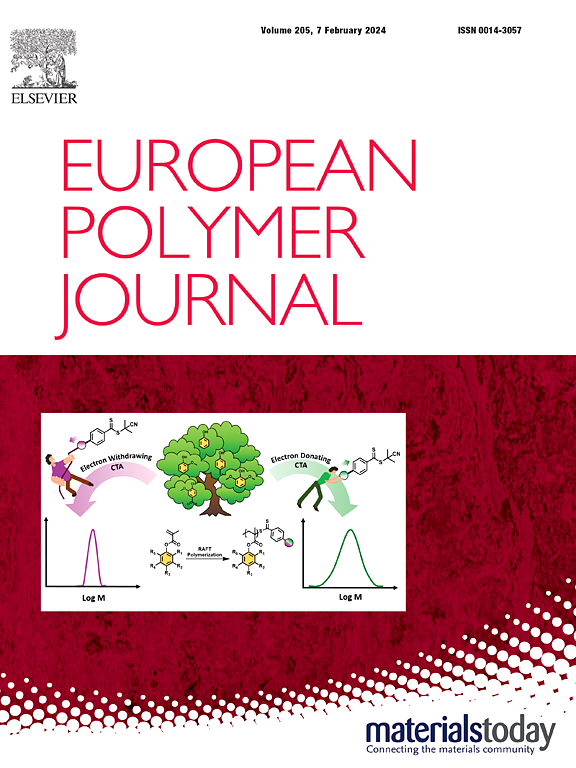Bactericidal and anti-adhesion polymers containing trialkyl-(4-vinylbenzyl)ammonium and plant-based tocopherol for coating applications
IF 5.8
2区 化学
Q1 POLYMER SCIENCE
引用次数: 0
Abstract
Polymers containing trialkyl-(4-vinylbenzyl)ammonium and plant-based tocopherol (abbreviated as P(C8N10TOC#), #=10, 30, 50, 70, and 90), where # indicates the molar content (%) of the tocopherol moiety in the side group, were prepared using the poly(4-chloromethylstyrene) (PCMS) as precursor and the trioctylamine and tocopherol as substituent to evaluate its abilities for coating application. Transparent P(C8N10TOC#) films were prepared on a glass substrate by spin coating and polymer films showed bactericidal and anti-adhesive properties with different alkyl chain lengths of ammonium and contents of tocopherol as substitution. It was found that the P(C8N10TOC#)s have a probability of bactericidal function and possess bactericidal properties above 49.6 and 94.6 % against Escherichia coli (E. coli; ATCC 8739) and Staphylococcus aureus (S. aureus; ATCC 6538), respectively. The anti-adhesive properties of the P(C8N10TOC90) films were shown against various contaminations with low surface energy. In detail, P(C8N10TOC#) films were expected to exhibit dual functional properties because they contained an optimum amount of hydrophilic trioctylammonium units and a sufficient amount of hydrophobic plant-based tocopherol units to impart bactericidal activity and low surface energy, respectively. Furthermore, the thermal, optical, and surface properties of the P(C8N10TOC#) films were investigated. Thus, this study reveals the potential of the P(C8N10TOC#) coating as a coating agent in various application areas and is also the first study to investigate the bifunctional properties of polymers containing quaternary ammonium and plant-based tocopherol moieties.

求助全文
约1分钟内获得全文
求助全文
来源期刊

European Polymer Journal
化学-高分子科学
CiteScore
9.90
自引率
10.00%
发文量
691
审稿时长
23 days
期刊介绍:
European Polymer Journal is dedicated to publishing work on fundamental and applied polymer chemistry and macromolecular materials. The journal covers all aspects of polymer synthesis, including polymerization mechanisms and chemical functional transformations, with a focus on novel polymers and the relationships between molecular structure and polymer properties. In addition, we welcome submissions on bio-based or renewable polymers, stimuli-responsive systems and polymer bio-hybrids. European Polymer Journal also publishes research on the biomedical application of polymers, including drug delivery and regenerative medicine. The main scope is covered but not limited to the following core research areas:
Polymer synthesis and functionalization
• Novel synthetic routes for polymerization, functional modification, controlled/living polymerization and precision polymers.
Stimuli-responsive polymers
• Including shape memory and self-healing polymers.
Supramolecular polymers and self-assembly
• Molecular recognition and higher order polymer structures.
Renewable and sustainable polymers
• Bio-based, biodegradable and anti-microbial polymers and polymeric bio-nanocomposites.
Polymers at interfaces and surfaces
• Chemistry and engineering of surfaces with biological relevance, including patterning, antifouling polymers and polymers for membrane applications.
Biomedical applications and nanomedicine
• Polymers for regenerative medicine, drug delivery molecular release and gene therapy
The scope of European Polymer Journal no longer includes Polymer Physics.
 求助内容:
求助内容: 应助结果提醒方式:
应助结果提醒方式:


